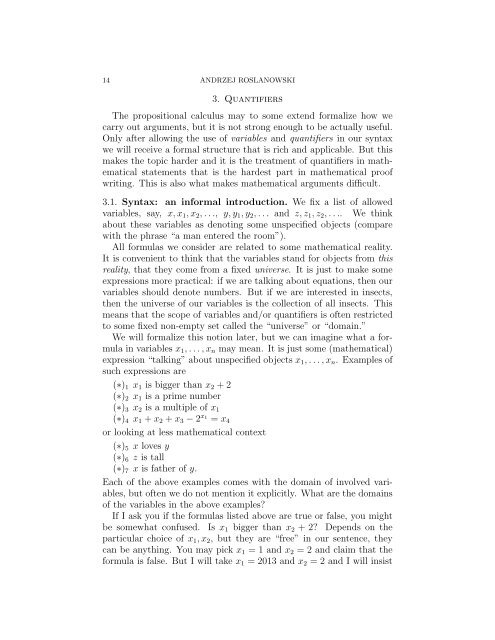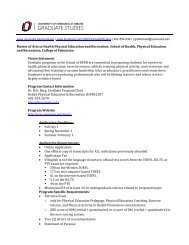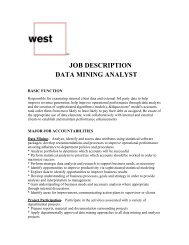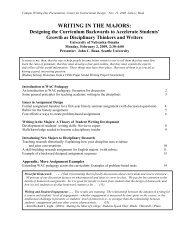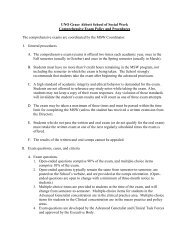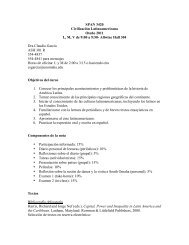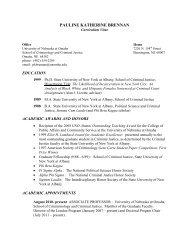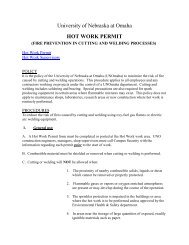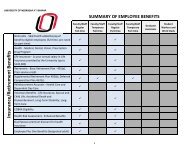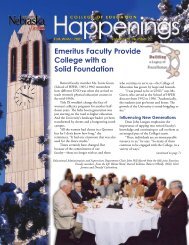Quantifiers - University of Nebraska Omaha
Quantifiers - University of Nebraska Omaha
Quantifiers - University of Nebraska Omaha
You also want an ePaper? Increase the reach of your titles
YUMPU automatically turns print PDFs into web optimized ePapers that Google loves.
14 ANDRZEJ ROSLANOWSKI<br />
3. <strong>Quantifiers</strong><br />
The propositional calculus may to some extend formalize how we<br />
carry out arguments, but it is not strong enough to be actually useful.<br />
Only after allowing the use <strong>of</strong> variables and quantifiers in our syntax<br />
we will receive a formal structure that is rich and applicable. But this<br />
makes the topic harder and it is the treatment <strong>of</strong> quantifiers in mathematical<br />
statements that is the hardest part in mathematical pro<strong>of</strong><br />
writing. This is also what makes mathematical arguments di cult.<br />
3.1. Syntax: an informal introduction. We fix a list <strong>of</strong> allowed<br />
variables, say, x, x 1 ,x 2 ,..., y, y 1 ,y 2 ,... and z,z 1 ,z 2 ,.... We think<br />
about these variables as denoting some unspecified objects (compare<br />
with the phrase “a man entered the room”).<br />
All formulas we consider are related to some mathematical reality.<br />
It is convenient to think that the variables stand for objects from this<br />
reality, thattheycomefromafixeduniverse. It is just to make some<br />
expressions more practical: if we are talking about equations, then our<br />
variables should denote numbers. But if we are interested in insects,<br />
then the universe <strong>of</strong> our variables is the collection <strong>of</strong> all insects. This<br />
means that the scope <strong>of</strong> variables and/or quantifiers is <strong>of</strong>ten restricted<br />
to some fixed non-empty set called the “universe” or “domain.”<br />
We will formalize this notion later, but we can imagine what a formula<br />
in variables x 1 ,...,x n may mean. It is just some (mathematical)<br />
expression “talking” about unspecified objects x 1 ,...,x n .Examples<strong>of</strong><br />
such expressions are<br />
(⇤) 1 x 1 is bigger than x 2 +2<br />
(⇤) 2 x 1 is a prime number<br />
(⇤) 3 x 2 is a multiple <strong>of</strong> x 1<br />
(⇤) 4 x 1 + x 2 + x 3 2 x 1<br />
= x 4<br />
or looking at less mathematical context<br />
(⇤) 5 x loves y<br />
(⇤) 6 z is tall<br />
(⇤) 7 x is father <strong>of</strong> y.<br />
Each <strong>of</strong> the above examples comes with the domain <strong>of</strong> involved variables,<br />
but <strong>of</strong>ten we do not mention it explicitly. What are the domains<br />
<strong>of</strong> the variables in the above examples?<br />
If I ask you if the formulas listed above are true or false, you might<br />
be somewhat confused. Is x 1 bigger than x 2 +2? Depends on the<br />
particular choice <strong>of</strong> x 1 ,x 2 , but they are “free” in our sentence, they<br />
can be anything. You may pick x 1 =1andx 2 =2andclaimthatthe<br />
formula is false. But I will take x 1 =2013andx 2 =2andIwillinsist
MATH 2230 — FALL 2013 15<br />
that it is true. Thus, if a formula has a “free” instance <strong>of</strong> a variable,<br />
then it does not make much sense to ask if it is true 12 .<br />
Why do I add the adjective “free” when talking about a variable?<br />
Note that not every occurrence <strong>of</strong> a variable is the same as any other.<br />
Compare the following two formulas:<br />
(a) x is a prime number bigger than 1000,<br />
(b) there is a prime number x such that x>1000.<br />
Again, if I ask you if the first formula is true, than you will reply<br />
“depends on x”. But the same question on the second formula will<br />
be clearly answered with “sure, this formula is true”! So what is the<br />
di↵erence? Both formulas involve a variable x, but<br />
• the first formula “speaks” about x, while<br />
• the second formula “speaks” about 1000, the x here could be<br />
totally eliminated. (We could have just say “there is a prime<br />
number bigger than 1000.)<br />
Look carefully what happens here. We have formula<br />
x is a prime number bigger than 1000<br />
(i.e., formula in (a)) and then, essentially, we add in front <strong>of</strong> it the<br />
phrase “there is an x such that” getting<br />
there is an x such that x is a prime number bigger than 1000<br />
(and you should agree that this is the formula in (b)). In general, if we<br />
have a formula with a free variable x, then by adding “there is an x such<br />
that” in front <strong>of</strong> it we obtain a formula where x is not free anymore.<br />
In situations like that we say that “the variable x got bounded by the<br />
existential quantifier”.<br />
In a parallel way we may consider adding “for all x we have that” in<br />
front <strong>of</strong> a formula with a free variable x, asinthesentence<br />
• for all real numbers x we have that x 2 0.<br />
This operation also creates a formula where x is not free anymore<br />
and we say then that “the variable x got bounded by the universal<br />
quantifier”.<br />
Thus we have two 13 quantifiers:<br />
• the existential quantifier 9x (it is read “there is an x such that”,<br />
“for some x we have”),<br />
• the universal quantifier 8x (it is read “for all x we have”, “for<br />
every x we have”).<br />
12 unless there are some conventions around, see later<br />
13 we may consider more quantifiers but these two are the most important
16 ANDRZEJ ROSLANOWSKI<br />
When you add them in front <strong>of</strong> a formula with a free variable x, we<br />
make this variable bounded. If x was the only free variable, then (in a<br />
sense) we may ask if the formula obtained this way is true or false.<br />
Some examples <strong>of</strong> mathematical formulas with quantifiers:<br />
(⇤) 8 (8x)(x 2 0)<br />
(⇤) 9 (9x)(x 3 124x +3=0)<br />
(⇤) 10 (9y)(5 sin(y) =⇡).<br />
We may have multiple quantifiers:<br />
(⇤) 11 (8x)(8y)(x + y = y + x)<br />
(⇤) 12 (8x)(9y)(x + y =2013)<br />
(⇤) 13 (9x)(8y)(2 x > sin(y))<br />
(⇤) 14 (8x)(8" >0)(9 >0)(8z)(|x z| < )|sin(x) sin(z)|
MATH 2230 — FALL 2013 17<br />
Warning: Never ever use quantifiers as abbreviations for English language<br />
phrases “for all” or “there exists” etc. Never write anything like<br />
“this solves the question 8x >0butwestillhavetodealwithc apple 0”<br />
or “we know that 9 a good object, but constructing it is more complicated”.<br />
3.2. Pro<strong>of</strong>s Involving <strong>Quantifiers</strong>. What makes mathematical theorems<br />
complicated is a sequence <strong>of</strong> alternating quantifiers, like in the<br />
sentence in (⇤) 14 . However, even with only one quantifier around we<br />
may get lost if the arguments are not presented properly.<br />
Some sentences are true in every possible interpretation (model).<br />
For instance, (9x)(x >0) ) (9x)(x >0) is always true, regardless<br />
<strong>of</strong> our interpretation <strong>of</strong> >. All (suitable) substitutions to tautologies<br />
<strong>of</strong> propositional calculus will have this property, but not only those.<br />
In this part we will meet several sentences which are true regardless<br />
<strong>of</strong> their interpretation. Sentences <strong>of</strong> this type are called logical validities,<br />
orlogical axioms, ortautologies <strong>of</strong> the quantifier calculus. We<br />
will give some justifications for them – these arguments could serve as<br />
“templates” for all “common sense” pro<strong>of</strong>s involving quantifiers.<br />
So, from now on let us fix:<br />
• the non-empty domain (universe) U <strong>of</strong> all variables,<br />
• formulas (x), (x) withatmostonefreevariablex.<br />
When a is an object from U, then we write (a) forthesentence<br />
obtained from (x) byreplacingeveryfreeoccurrence<strong>of</strong>x with a.<br />
Similarly for .<br />
We will use x 0 to denote some fixed objects from U —note,thisis<br />
not a variable!<br />
Remark 3.2.1. Many mathematical theorems have the form <strong>of</strong> an implication.<br />
There are various strategies to prove the conditional ' ) but<br />
most <strong>of</strong>ten the direct approach is best. We assume that the hypothesis<br />
(antecedent) ' is true and we argue that the conclusion (consequent)<br />
holds true.<br />
Sometimes we want to argue for a biconditional statement ' , .<br />
Then most <strong>of</strong>ten we prove the two implications separately (remembering<br />
Corollary 2.2.5(9)).<br />
Proposition 3.2.2. The sentence<br />
(8x) (x) ) (9x) (x)
18 ANDRZEJ ROSLANOWSKI<br />
is a tautology <strong>of</strong> the quantifier calculus.<br />
Pro<strong>of</strong>. Assume that (8x) (x) is true, that is, for every x 0 ,thesentence<br />
(x 0 )holdstrue. Chooseanyx 0 from the domain U and fix it. Then it<br />
follows that (x 0 )istrue. Consequently,x 0 witnesses that there exists<br />
an x such that (x) istrue. Thus,(9x) (x) holds,sowehaveshown<br />
the implication<br />
holds. This completes the pro<strong>of</strong>.<br />
(8x) (x) ) (9x) (x)<br />
Proposition 3.2.3. The following sentences are tautologies <strong>of</strong> the quantifier<br />
calculus:<br />
(a) (8x)( (x) ^ (x)) , (8x) (x) ^ (8x) (x).<br />
(b) (9x)( (x) _ (x)) , (9x) (x) _ (9x) (x).<br />
(c) (8x) (x) _ (8x) (x) ) (8x)( (x) _ (x)).<br />
(d) (9x)( (x) ^ (x)) ) (9x) (x) ^ (9x) (x).<br />
Pro<strong>of</strong>. (a) To prove this biconditional we will argue for the two implications<br />
separately.<br />
()) Let us assume that<br />
(i) (8x) (x) ^ (x) holds true.<br />
Suppose that x 0 is arbitrary but fixed. It follows from (i) that<br />
is true, and hence<br />
that<br />
(ii)<br />
(x 0 ) ^ (x 0 )<br />
(x 0 )holdstrue. Sincex 0 was arbitrary we conclude<br />
(8x) (x) holdstrue.<br />
Again assuming x 0 is arbitrary, we know that (x 0 ) ^ (x 0 )istrueby<br />
(i). It follows that (x 0 ) is true as well. Hence, we get<br />
(iii)<br />
(8x) (x) holdstrue.<br />
Finally, clauses (ii) and (iii) imply that the conjunction<br />
(8x) (x) ^ (8x) (x)<br />
is true, completing the pro<strong>of</strong> <strong>of</strong> the implication.<br />
(() Assume that (8x) (x) ^ (8x) (x) holdstrue.Thus<br />
and<br />
(⇤)<br />
(⇤⇤)<br />
(8x) (x) istrue,<br />
(8x) (x) istrue.<br />
⇤
MATH 2230 — FALL 2013 19<br />
Now, suppose that x 0 is arbitrary but fixed. It follows from (⇤) that<br />
(x 0 )istrue,andby(⇤⇤) wegetthat (x 0 )holds.Therefore,<br />
(x 0 ) ^ (x 0 )<br />
is true. Since x 0 was arbitrary, we conclude that (8x)( (x) ^ (x)) is<br />
true.<br />
Consequently, the desired implication is true and the pro<strong>of</strong> <strong>of</strong> the<br />
biconditional is complete.<br />
(b) To show this biconditional we will prove the two implications<br />
separately.<br />
()) Assume (9x)( (x) _ (x)) holds true. Let x 0 be such that<br />
(x 0 ) _ (x 0 )<br />
is true. Hence, one <strong>of</strong> the statements,<br />
consider the two possible cases.<br />
(x 0 )or (x 0 ), is true. Let us<br />
Case 1: (x 0 )istrue.<br />
Then, x 0 witnesses that (9x) (x) holds true. Consequently, the disjunction<br />
(9x) (x) _ (9x) (x)<br />
holds true.<br />
Case 2: (x 0 )istrue.<br />
Then, similarly as in the previous case, except interchanging and ,<br />
we conclude that the disjunction<br />
holds true.<br />
(9x) (x) _ (9x) (x)<br />
In both cases we concluded that the disjunction (9x) (x)_(9x) (x)<br />
holds true. Therefore the implication is justified.<br />
(() Assume (9x) (x) _ (9x) (x) holdstrue. Thus,either(9x) (x)<br />
or (9x) (x) istrueandthisleadstotwopossiblecases.<br />
Case 1: (9x) (x) istrue.<br />
Then we may choose an x 0 so that (x 0 )holds. Itthenfollowsthat<br />
(x 0 ) _ (x 0 )istrue.Consequently,x 0 witnesses that<br />
(9x)( (x) _ (x))<br />
holds true.<br />
Case 2: (9x) (x) istrue.<br />
By interchanging and in the previous case, we conclude that<br />
(9x)( (x) _ (x))
20 ANDRZEJ ROSLANOWSKI<br />
holds true.<br />
In both cases we conclude that (9x)( (x) _ (x)) is true. Therefore<br />
the pro<strong>of</strong> <strong>of</strong> the implication is complete. Hence, the biconditional (b)<br />
is shown.<br />
(c) Assume that (8x) (x)_(8x) (x) holds true. Then either (8x) (x)<br />
or (8x) (x) istrue,sowemayconsidertwopossiblecases.<br />
Case 1: (8x) (x) istrue.<br />
Let x 0 be arbitrary but fixed. By the assumption <strong>of</strong> the current case,<br />
(x 0 ) holds true. Hence, the disjunction (x 0 ) _ (x 0 )alsoholdstrue.<br />
Since x 0 was arbitrary, we conclude<br />
(8x)( (x) _ (x))<br />
holds true.<br />
Case 2: (8x) (x) istrue.<br />
Interchanging and in the previous argument we justify that in the<br />
current case<br />
(8x)( (x) _ (x))<br />
also holds true.<br />
In both possible cases we concluded that<br />
(8x)( (x) _ (x))<br />
holds true, so the implication is shown.<br />
(d) Assume (9x)( (x) ^ (x)) holds true. Let x 0 be a witness for<br />
this, that is it is chosen so that (x 0 ) ^ (x 0 )istrue. Thenboth (x 0 )<br />
and (x 0 )aretrue. Since (x 0 )istrue,weseethat(9x) (x) holds,<br />
and since (x 0 )istrueweseethat(9x) (x) holds.Consequently,the<br />
conjunction<br />
(9x) (x) ^9x (x)<br />
holds true, and this completes the pro<strong>of</strong> <strong>of</strong> the implication.<br />
We have shown finally, that the four statements in Proposition 3.2.3<br />
are true, and this completes the pro<strong>of</strong>.<br />
⇤<br />
Remark 3.2.4. The sentence<br />
(8x)( (x) _<br />
(x)) ) (8x) (x) _ (8x) (x)<br />
may be false. For instance, let x range over natural numbers and (x)<br />
means “x is even” and (x) means“x is odd.” Then, (8x)( (x)_ (x))<br />
holds true, but both (8x) (x) and(8x) (x) arefalse.
MATH 2230 — FALL 2013 21<br />
Definition 3.2.5. Two sentences and (<strong>of</strong> quantifier calculus) are<br />
equivalent if the biconditional ( , ) is a tautology <strong>of</strong> the quantifier<br />
calculus.<br />
Formulas (x) and (x) areequivalent if the sentence<br />
(8x)( (x) , (x))<br />
is a tautology. Similarly if more free variables are involved.<br />
Example 3.2.6. ¿Thefollowingpairs<strong>of</strong>formulasareequivalent:<br />
(1) (8x)( (x) ^ (x)) and (8x) (x) ^ (8x) (x).<br />
(2) (9x)( (x) _ (x)) and (9x) (x) _ (9x) (x).<br />
(3) ¬(9x) (x) and(8x)¬ (x).<br />
(4) ¬(8x) (x) and(9x)¬ (x).<br />
(5) ¬(8x)(9y) (x, y) and(9x)(8y)¬ (x, y).<br />
3.3. Syntax: First Order Logic. We start with fixing a lis <strong>of</strong> symbols<br />
that we will use in our formulas. Some symbols are independent<br />
<strong>of</strong> the area <strong>of</strong> mathematics that we are working in are called “logical”<br />
or “syntax” symbols. “Logical” symbols include:<br />
(~) q 1 variables: x, x 1 ,x 2 ,..., y, y 1 ,y 2 ,... and z,z 1 ,z 2 ,...;<br />
(~) q 2 grouping symbols: (, )<br />
to increase readability we may use also [ , ], but they should be<br />
interpreted just as a di↵erent way <strong>of</strong> writing round parentheses;<br />
(~) q 3 logical connectives: ^, _, ¬, ), ,;<br />
(~) q 4 quantifiers: 9, 8.<br />
We also have area specific symbols which may include:<br />
(~) q 5 constants like 0, 1, 2,e,⇡ etc;<br />
(~) q 6 relational symbols like
22 ANDRZEJ ROSLANOWSKI<br />
1, while x y has an arity <strong>of</strong> 2. Often times, if F is a binary functional<br />
symbol, then we <strong>of</strong>ten write it between the terms. For example, 2 + 7,<br />
3 · x, x y, andsoon.OtherwiseweusetheformF (x, y, z) etc.<br />
Definition 3.3.1. (1) An alphabet for a first order language is a<br />
list A <strong>of</strong><br />
(a) constants: c 1 ,c 2 ,c 3 ,...<br />
(b) relational symbols: R 1 ,R 2 ,R 3 ,...<br />
(each with fixed arity) and<br />
(c) functional symbols: F 1 ,F 2 ,F 3 ,...<br />
(each with fixed arity).<br />
(2) For the alphabet A, wedefineterms and formulas <strong>of</strong> the language<br />
L(A) asfollows.<br />
(a) Variables and constants are terms.<br />
(b) If F i is an n-ary function symbol and t 1 ,...,t n are terms,<br />
then F (t 1 ,...,t n )isaterm.<br />
(c) If t 1 ,t 2 are terms, then t 1 = t 2 is a formula.<br />
(d) If t 1 ,...,t n are terms and R is an n-ary relational symbol,<br />
then R(t 1 ,...,t n )isaformula.<br />
(e) If , ,... are formulas, then so are<br />
¬ , ( ^ ), ( _ ), ( ) ), ( , ).<br />
(f) If is a formula, then both (8x) and (9x) are formulas.<br />
Remark 3.3.2. If the function symbol is binary and we put it between<br />
the terms (i.e., we write t 1 Ft 2 ), then we add parentheses. So we write<br />
then (t 1 Ft 2 ). Without the parentheses, the structure <strong>of</strong> complex terms<br />
can be misinterpreted.<br />
Definition 3.3.3. Aformulawithoutfreevariablesiscalledasentence.<br />
Defining derivations in first order logic is somewhat more complicated<br />
than in propositional calculus (subsection 2.3). We may be lazy<br />
though and take as the logical axioms all tautologies <strong>of</strong> the quantifier<br />
calculus we can come with, including all substitutions to tautologies <strong>of</strong><br />
propositional calculus. Then there are two rules <strong>of</strong> inference: modus<br />
ponens and the substitution rule. The latter can be described as follows<br />
15 :<br />
If t is a term and is a formula possibly containing the variable x,<br />
then [t/x] istheresult<strong>of</strong>replacingallfreeinstances<strong>of</strong>x by t in .<br />
The substitution rule states that for any and any term t, onecan<br />
conclude [t/x] from provided that no free variable <strong>of</strong> t becomes<br />
bound during the substitution process.<br />
15 quoted after Wikipedia
MATH 2230 — FALL 2013 23<br />
Thus we develop syntactics like in the propositional calculus case. We<br />
also study semantics (the model theory), but this is a totally di↵erent<br />
story.<br />
3.4. Exercises.<br />
Problem 3.1. Using binary relational symbols
24 ANDRZEJ ROSLANOWSKI<br />
Problem 3.4. Let (x, y) andbeaformulawithatmosttw<strong>of</strong>ree<br />
variables x and y. Suppose also that no occurrence <strong>of</strong> x or y in is<br />
bounded by a quantifier. Prove that the following sentences are true.<br />
(1) (8x)(8y) (x, y) ) (8x) (x, x)<br />
(2) (9x) (x, x) ) (9x)(9y) (x, y)<br />
(3) (9x)(8y) (x, y) ) (8y)(9x) (x, y)<br />
Problem 3.5. Justify Remark 3.2.6.<br />
Problem 3.6. Which <strong>of</strong> the following sentences are always true (i.e.,<br />
which sentences are tautologies <strong>of</strong> the quantifiers calculus) ? Justify<br />
those which are tautologies, provide counterexamples for those which<br />
are not.<br />
(1) (8x) (x, x) ) (8x)(8y) (x, y)<br />
(2) (9x)(9y) (x, y) ) (9x) (x, x)<br />
(3) (8y)(9x) (x, y) ) (9x)(8y) (x, y)<br />
(4) (8y)(8x) (x, y) , (8x)(8y) (x, y)<br />
(5) (9y)(9x) (x, y) , (9x)(9y) (x, y)<br />
(6) (8x) (9x) (x) ) (x)<br />
(7) (8x) (x) ) (9x) (x)<br />
(8) (8x) (x) ) (8x) (x) ) 8x (x) ) (x)<br />
(9) (8x) (x) , (8x) (x) ) 8x (x) , (x)<br />
(10) (8x) (x) ) (8y) (y)<br />
Problem 3.7. Aformulaisinprenex form if it is written as a string<br />
<strong>of</strong> quantifiers (referred to as the prefix) followed by a quantifier–free<br />
part (referred to as the matrix). 16 For each <strong>of</strong> the following formulas<br />
find a formula in the prenex form equivalent to the given formula and<br />
the matrix simplified as much as possible.<br />
(1) ¬(8x)(8y)(x + y = y + x)<br />
(2) ¬(8x)(9y)(x + y =2013)<br />
(3) ¬(9x)(8y)(2 x > sin(y))<br />
(4) ¬(8" >0)(9 >0)(8x)(8z)(|x z| < )|sin(x) sin(z)| 0)(9 >0)(8z)(|x z| < )|2 x 2 z |


